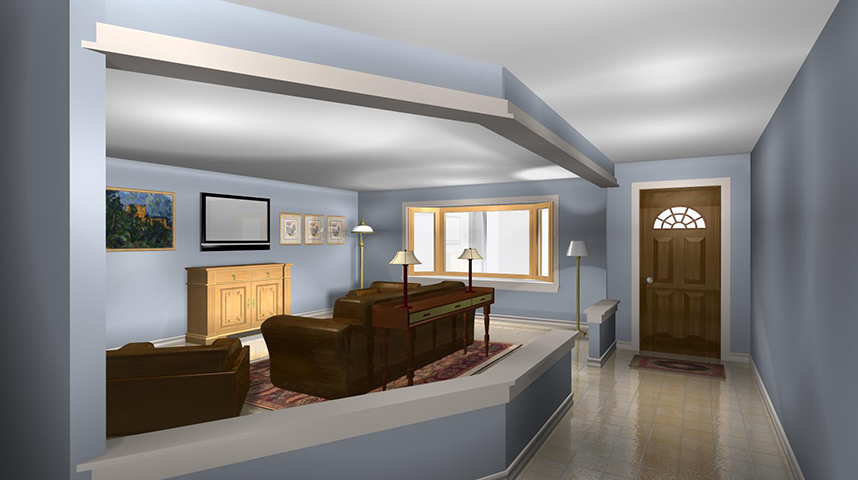Read more like this over at Home Building Timeline
Ahhh, the 80’s, a decade with flair. Mastered in previous decades, everything had flair. Pants, jeans, skirts, even eyelashes, all had flair. I know. I was there. (…Pausing to reflect…Holy Cow! I’m so glad that decade is over.)
Planning, building, and selling houses was anchored in the phrase, “This house has flair,” which apparently made it more desirable. The ‘flair’ came from features like wine-colored carpet paired with teal walls and shrimp accents. There was also the rebirth of a Victorian embellishment made-over for modern times, half-walls with spindles.
The spindled half-wall was the connecting link between two eras, one of many-roomed, compartmentalized living layouts, and the one of wide-open floor plans in decade two of the twenty-first millennium. It was experimental on its best day, offering a more open look, but without the nervy commitment to remove entire walls. A lot of 80’s houses were built with half-walls and spindles. Since then, living-space creators have made the jump to fully open plans, which make half-walls with spindles obsolete.
So, that’s how we got here – discussing what to do with an old look in a new time. But, there’s one thing that was as meaningful then as now…money. It still doesn’t grow on trees. In addition, the challenge has not changed – to build anything costs lots of money.
While it’s true that the overall economy has seen a huge surge for the better in 2017, it’s important to note that this surge is only huge by comparison with the dire desperation of recent years. ‘Caution’ is still a byword to live with. So, when it comes to remodeling, even something as simple as giving a makeover to a room with a half-wall and spindles, it’s advisable to take of look at how the dollars will fly away, and the dominoes will fall, as a result of the renovation.
The following illustrations take into account a restrained budget. So, the solutions offered will only include options which can be paid for with a little money plus a lot of sweat.
ABOUT THE COLORS
The chosen color-schemes are to show contrast, not perfection. These images travel from my computer through countless servers, and satellites. Each one takes a bite out of the information rendering the image you see a mere shadow of its original self.
THE WAY IT WAS
The first illustration is a classic example of a 1980’s home. The Foyer runs parallel to the Living Room. In the 50’s and 60’s, the wall between the two would have been solid. The half wall allowed more light to play between the rooms, while the spindles offered the compromise of visual separation. But, because the day’s style called for stained wood, it was still dark in the house.
In all of the illustrations, the furnishings remain unchanged. Only the half-wall, spindles, and trim are affected.

PAINT THE SPINDLES
OPTION 1:
Paint the trim with a complimentary color. It’s too expensive to strip and re-stain all that wood. Primer and Paint will create a new look, and leave the old structure intact, a real money saver.

OPTION 2:
An slight color change, subtle though it may be, makes a big difference throughout the entire space. Light bounces differently, its altered reflections ricocheting through the space illuminating an entirely different ambiance.

OPTION 3 :
Classic White, whether it’s linen, dove gray light, smoke, or glossy prime, white makes light more bright.

BONUS OPTION
The Chinese have the world’s oldest, continuous civilization. They’ve done something right. Maybe a little chinoiserie influence is in order.

REMOVE THE SPINDLES
OPTION 4
In most cases the spindles are just ornamental, serving no structural purpose at all. If a beam is over the spindles, then it’s very likely that that beam is also just decorative. Even so, it’s recommended that an experienced carpenter be given the opportunity to determine whether or not the spindles are load-bearing. If not, get’em outta there!
Color can still make a difference. The following two illustrations show some options.


REPLACE THE SPINDLES
OPTION 5
If it is determined that the spindles are in fact holding up the house, don’t despair. Most load-bearing wall/spindle/beam combinations can be altered by substituting a post. Again, get a carpenter to help make the best diagnosis.
The two following illustrations are different only in stain and paint.


CUT DOWN THE WALL
Limited only by the tolerance for sweat, this option offers a lot more of an open feel, but doesn’t touch the expensive parts – floor and ceiling – so the budget is protected. Stain or paint? Take your pick. Define the room or release the light. It’s your choice.
The next two illustrations show a wall only two feet high. It should be at least that, so it’s easy to see, and doesn’t become a trip hazard. If needed, a column can be added for support, as in earlier pics.


HERE’S WHERE WE ERASE THE 80’s
A fresh coat of paint can hide a lot of misery. The illustration, below, shows how a modern color can be a perfect finishing touch.

GOING FOR BROKE
Finally, what would it look like to throw caution to the wind and just gut the whole thing? Pretend money’s of no concern, and patching the floor and ceiling will be easy to pay for. The first picture, below, shows the half-wall removed, but keeps the beam for room definition. While, the last picture removes everything, leaving a space in which there’s ample room to spread out.


CONCLUSION
Every project takes time, money, and effort (sweat). But, approaching that project with an eye tuned to using muscle in order to save money, can make or break a project’s start time, duration, and finishing touches. Spend all you want. But, look into the future to see what you’re going to get for it. Hey, at least it won’t be the 80’s.
